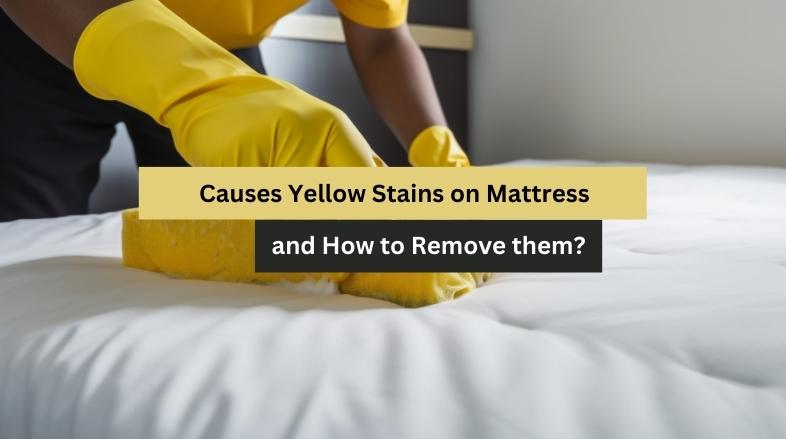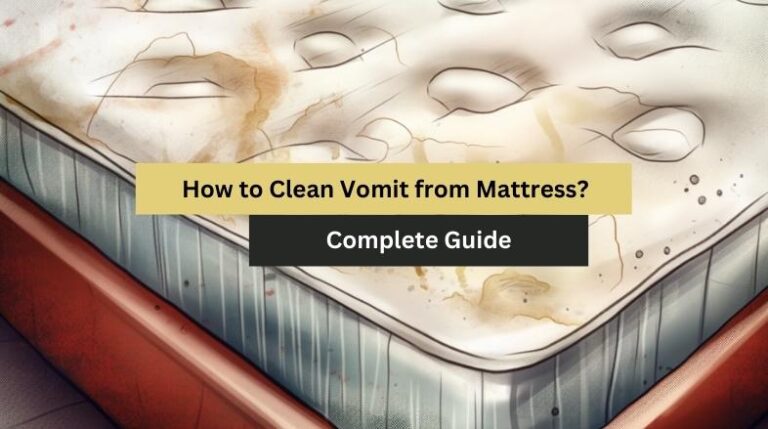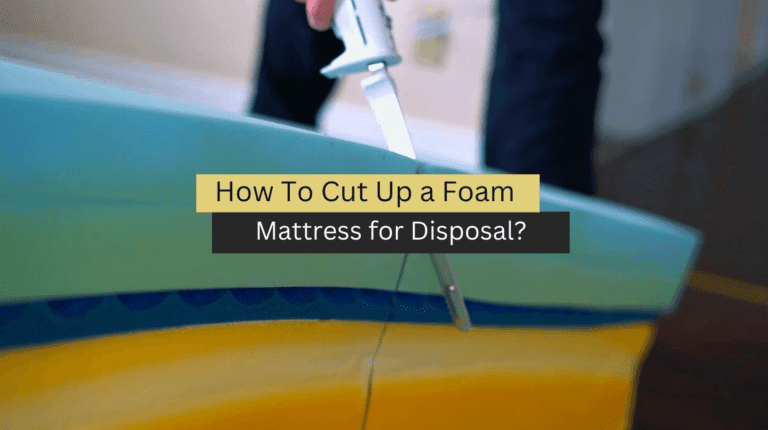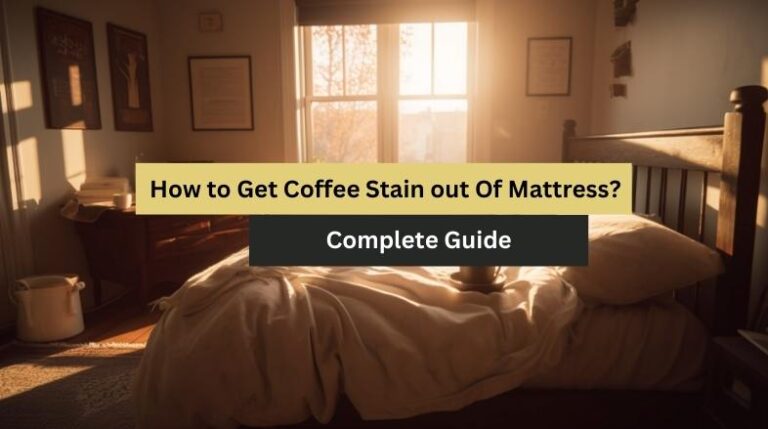Causes Yellow Stains on Mattress and How to Remove them?
Have you recently discovered yellow spots on your mattress? Don’t be alarmed; they are quite regular occurrences. But understanding what causes them is critical so that you may take preventive actions in the future, keep your sleeping environment clean, and extend the life of your mattress. Yellow stains can be caused by spontaneous oxidation or by substances such as urine, sweat, body oil, and vomit. While some stains are easily removed, others may necessitate comprehensive cleaning processes or even a replacement if the mattress is too old or damaged to be repaired.
In this article, I will walk you through a detailed tutorial on yellow stains on mattresses, including causes, prevention, cleaning, and other pertinent information.
Causes of Yellow Stains on Mattresses

As a mattress lover and cleaning enthusiast, I examined the most prevalent causes of yellow stains on mattresses. Here are the reasons:
Natural Oxidation
Oxidation is the process through which materials mature due to exposure to environmental components such as sunshine. This is most common on the mattress’s surface and causes discoloration over time. Though it is unappealing, this yellowing is not detrimental to the mattress. Although oxidation stains cannot be removed, they can be slowed by wearing a mattress protector.
Urine
One of the most common causes of yellowish stains on mattresses is urine. If left untreated, it can swiftly spread over a mattress, resulting in a stronger stench if it remains on the surface for an extended period. The good news is that fresh and dried pee stains can be cleaned with a strong or enzyme-based cleaning solution.
Sweat And Body Oil
Our bodies’ oil and sweat accumulate and infiltrate the mattress with time, causing fiber deterioration and producing yellowish patches. The accumulation of sweat and oil also promotes mold growth, resulting in a musty odor. Yellow stains created by body oils and sweat can be removed with appropriate cleaning solutions, and it’s better to spot-clean and frequently wash your beddings to minimize the buildup of bacteria and moisture.
Vomit
While it’s an unpleasant subject, vomit stains can grow on the surface of your mattress, causing stubborn yellowish streaks. Vomit is highly acidic and can quickly permeate the fibers of your mattress, and given the unattractive appearance of the stain, cleaning it as soon as possible becomes vital. Eliminating vomit stains entails spot cleaning and using appropriate chemicals or natural remedies on the affected surface.
Rust
Rusted bed frames or springs, while uncommon, can crumble with time and leave ugly stains on your mattress. These rust stains are extremely obstinate and can spread if left untreated, so examine your bed frame and springs for symptoms of rust and repair them as needed.
Water Stains
Water stains can also cause yellowish stains on mattresses. Water spills produced by an accident or moisture buildup caused by a humid atmosphere can quickly cause stains on your mattress. Consider the yellow stains caused by water damage. Dab the wetness with a highly absorbent towel or use a natural cleaning solution to eliminate the stains.
You May Also Read: How to Clean Blood Stain From Mattress?
Prevention of Yellow Stains on Mattresses
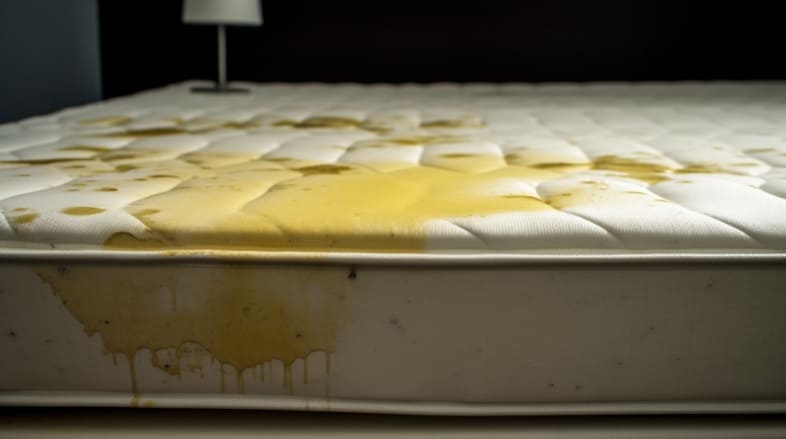
Good mattress care is essential for avoiding yellow stains on your bedding. Here are some suggestions for avoiding such stains.
Use A Mattress Protector
A mattress cover is essential for preventing yellow stains produced by spills and stains. It serves as the initial line of defense and is readily removed, washed, and replaced in the event of spills or mishaps. Mattress covers also help to prevent the accumulation of dirt, dust, and sweat, which can develop yellow stains over time.
Regularly Wash Linens
Cleaning your linens and bedding regularly prevents yellow stains caused by sweat and body oils from accumulating on your mattress over time. Bedding can hold a lot of body oil, and washing it regularly helps limit how much penetrates into the mattress. Depending on usage, wash your bedding monthly or biweekly. This procedure also aids in the reduction of mites, which feed on sweat, allergies, and dead skin, among other deposits.
Avoid Eating Or Drinking On The Bed
Eating or drinking in bed can make a mess, and spills can easily leave stains on your mattress. Food and alcohol should be kept out of the bedroom, especially if you are prone to mishaps. If it’s difficult to resist munching in bed, store your food and beverages on a separate tray that you can swiftly clear away after each usage.
Use A Dehumidifier
Yellow stains on a mattress can be caused by high humidity in the bedroom. Mold development and moisture buildup are encouraged in a humid environment, resulting in unattractive yellow blotches. The best way to deal with this issue is to use a dehumidifier, which regulates the humidity levels in your bedroom. To reduce humidity buildup, keep proper air movement in your bedroom and avoid storing moisture-inducing things like damp clothes or towels.
You can preserve your mattress in good shape, free of yellow stains, and increase its lifespan by following these simple procedures.
Safety Concerns When Sleeping on a Mattress with Yellow Stains
Sleeping on a mattress with yellow stains can harm one’s health. These are some safety precautions you should take:
- Yellow stains can appear naturally due to oxidation. Still, they can also be produced by bodily fluids and moisture buildup, which can promote the growth of hazardous germs such as mold and bacteria.
- Mold growth is a typical problem on mattresses, particularly those exposed to a humid atmosphere or moisture for an extended period. Mold growth can cause respiratory difficulties such as allergies, asthma, and other serious health problems caused by mycotoxins.
- If you detect spots of yellow stains or a musty odor from your mattress, it may be time to replace it. Sleeping on a potentially dangerous surface caused by spillage, wetness, or mold growth risks your health.
- Yellow stains could also suggest the presence of dead skin cells, dust mites, or other microscopic organisms that can grow inside your mattress. If handled improperly, these organisms can cause allergic reactions, sneezing, and other health issues.
Appropriately.
It’s recommended to clean your sleeping mattress regularly and replace it when it’s past its prime to maintain optimal safety and hygiene. Keeping optimal sleeping conditions will result in improved health and well-being.
Signs That It’s Time to Replace Your Mattress
Being a mattress enthusiast, I realize how difficult it may be to replace a mattress. It’s not always easy to tell whether it’s time to replace your mattress, but here are several telltale indicators.
Yellow Stains
Yellow stains typically develop over time due to natural oxidation, bodily fluids, and moisture buildup. While some stains are easily cleaned, stubborn spots may indicate a larger issue with your mattress. They can also cause odors and mold growth, making it an unsanitary sleeping surface. If you find yellow stains on your mattress, it’s time to think about changing it.
Proper Care Of Your Mattress
Appropriate care and maintenance will help your mattress last longer. Unfortunately, this does not guarantee that it will last indefinitely. According to the Better Sleep Council, a mattress should be replaced every seven years. Your body evolves with time, and your demand for comfort and support grows. Sagging, bumps, and coils that can be felt through the fabric indicate it’s time to replace your mattress.
Other signs that you may need a new mattress include:
- Your mattress is unpleasant, and you wake up with aches and pains.
- Your mattress has springs you can feel and produce noise when moving.
- You notice bed bugs, dust mites, or other creepy crawlies on the surface of your mattress.
- If you notice a persistent odor coming from your mattress, it could result in mold forming due to moisture trapped inside the mattress.
When you observe any of these indicators, you must replace your mattress. Updating your mattress gives you better sleep quality and protects you from the health risks of sleeping on an old mattress.
Best Ways to Clean Yellow Stains on Mattresses
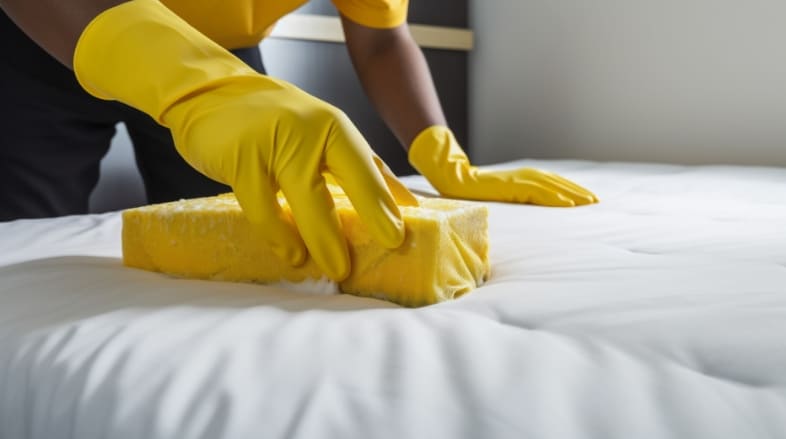
As someone who has experienced yellow stains on my mattress, I have discovered two excellent methods to eradicate them. The following are the detailed instructions for both methods:
Natural Cleaner Method
Supplies:
- Baking powder
- distilled white vinegar
- Peroxide of hydrogen
- Lavender essential oil (optional)
- Cleaner of carpets
- Dry fabric
- The spray bottle
Instructions:
- Remove all of your mattress’s linens and other materials.
- Remove any loose material from the mattress using a vacuum.
- To make a paste, combine one cup of baking soda, salt, and water in a basin.
- You can alternatively spray the area liberally with a mixture of equal parts water and white vinegar.
- Sprinkle with baking soda and set aside overnight (or at least for eight hours).
- When the residue has dried, vacuum it up and assess the discoloration. Repeat the technique as needed until you are satisfied with the outcome.
Way of Cleaning using Chemicals
Supplies:
- Detergent
- Cleaner of carpets
- Dry fabric
Instructions:
- Remove all of your mattress’s linens and other materials.
- Remove any loose material from the mattress using a vacuum.
- Use detergent to clean it in spots.
- To remove the residue, dab it with a moist towel.
- Vacuum again and allow drying completely.
To avoid ruining your mattress, you must be cautious when cleaning it. Always test any cleaning solution on a small cloth patch to ensure it does not damage or discolor it. Following these simple measures, you can keep your mattress fresh and free of yellow stains.
How to Clean a Mattress Pad
Washing a mattress pad is critical for preserving quality and extending life. Here are two methods for cleaning your mattress pad:
Natural Cleaning Procedure
Supplies:
- Distilled white vinegar
- Water
- The spray bottle
Instructions:
- Combine equal parts water and vinegar.
- Fill a spray bottle halfway with the mixture and spray it on the mattress pad.
- Please keep it on the pad until it dries.
- You can also sun-dry the pad, which will also eliminate any stink.
Chemical Cleaner Method
Supplies:
- Gentle soap
- Warm water
- a fresh, dry towel
Instructions:
- Begin by vacuuming the mattress pad’s surface to remove dirt and other debris.
- A mild soap and warm water solution can be used for more thorough cleaning.
- With a clean, dry cloth, blot up any excess liquid.
- Let the mattress pad to thoroughly dry before replacing it on the bed.
Avoid using hot water or harsh chemicals since these can damage the mattress pad material. When cleaning the mattress pad, always consult the manufacturer’s cleaning instructions. Clean your mattress pad regularly to avoid the accumulation of dirt or bacteria that could impair the quality of your sleep.
Frequently Asked Questions
Is it safe to use OxiClean on a mattress?
OxiClean can remove yellow stains from a mattress because it is a powerful stain remover. However, spot-testing any solution on a small, hidden portion of the mattress first is essential to ensure it does not damage its fabric. Once confirmed, mix a paste of OxiClean and water and apply it to the yellow stain using a clean cloth or sponge, then wipe with cold water to remove any residue.
What happens when you pour baking soda in your bed?
Pouring baking soda into your bed might assist in deodorizing and refreshing it. Baking soda can absorb any unpleasant odors or odors on your mattress, leaving it smelling fresh and clean. It can also aid in removing any moisture or moisture-related damage to the mattress. After sprinkling, let the baking soda lie for several hours, then suck up the residue with a vacuum cleaner.
Conclusion
Taking care of your mattress is critical to getting a good night’s sleep. Using a mattress protector, washing bedding regularly, avoiding eating or drinking in bed, and using a dehumidifier can help prevent yellow stains produced by body fluids or spills. When it’s time to replace the mattress, yellow stains or evidence of wear and tear are immediately visible, suggesting the need for a new one. Both natural and chemical cleaners can be used to remove yellow stains from a mattress or mattress pad. Nonetheless, it is best to be gentle when cleaning and always to test any cleaning solution on a small area first.

